The Mexican Peso reverses earlier losses against the US Dollar after Q1 US GDP is revised down.
Several analysts say MXN has peaked and is on the way down.
Negative fundamentals include the Mexican and US presidential elections and a narrowing MXN-supportive interest-rate differential.
The Mexican Peso (MXN) makes up earlier loses against the US Dollar (USD) on Thursday after US GDP data showed a downward revision on first quarter GDP growth data due to slower consumer spending.
The second estimate of annualized US GDP growth in Q1 was revised down to 1.3% from a first estimate of 1.6%, according to data from the US Bureau of Economic Analysis, released on Thursday. This was also well below the 3.4% final estimate for Q4 but in line with analysts’ expectations. The data accelerated a sell-off in USD/MXN which fell to 16.95 at the time of publication, from trading above 17.00 earlier in the day.
The GDP data suggests the US economy is not as strong as analysts had previously thought, and could indicate declining inflation, which in turn will lead the Federal Reserve (Fed) to lower interest rates – a negative for the USD since lower interest rates attract lower foreign capital inflows.
Mexican jobless data showed a 2.6% rate of unemployment in April, up from 2.3% in March, according to data from INEGI released on Thursday. The result was in line with analysts expectations.
Overall investors are unwinding their MXN long bets due to multiple risk factors on the horizon. The Mexican presidential elections on Sunday, the US presidential elections in November, and a growing shift in US interest-rate expectations are all weighing on the Peso, which is vulnerable to reversing its long-term uptrend, according to analysts.
USD/MXN is exchanging hands at 16.96 at the time of writing, EUR/MXN is trading at 18.36 and GBP/MXN at 21.59.
Mexican Peso subject to a growing number of risk factors
The Mexican Peso trades overall lower this week as investors close their long bets ahead of potentially market-moving events bleeping on the radar in the near and medium-term.
The Mexican presidential election on Sunday is likely to result in the election of Claudia Shienbaum of the Morena party, who leads by 20% in the polls. She’ll take over from her predecessor Andres Manuel Lopez Obrador (AMLO), also of Morena.
Shienbaum is likely to continue the generous social-welfare programme that made AMLO popular and has pledged to increase the minimum wage by circa 11%. This is likely to boost consumer spending, a key driver of growth in recent quarters, but could make it difficult for the Bank of Mexico (Banxico) to bring down inflation, says Kimberley Sperrfechter, Emerging Markets Economist at Capital Economics.
“A victory for Claudia Sheinbaum in Mexico’s election on Sunday is likely to see a continuation of Amlo’s generous social policies – which will also make Banxico’s fight against inflation harder,” says Sperrfechter.
Threat of being trumped
A clear and present danger for the Mexican Peso is the possibility of Donald Trump’s reelection in November. The US and Mexican trade agreement (USMCA) is up for review in 2026, and there is a risk Trump, if re-elected, might reintroduce tariffs on Mexican goods. Such a move would also hamper Mexico’s near-shoring prospects.
For this reason, Sperrfechter thinks that the Peso’s “period of outperformance has largely run its course” and expects the currency to substantially weaken to $19-$20 during the next president’s tenure.
Mexican Peso’s interest-rate advantage gap to close – Rabobank
The Mexican Peso’s long-term uptrend has been supported by the high interest rates (11.0%) in Mexico, which in turn attract foreign investor inflows.
Banxico lowered interest rates by 0.25% in March and is expected to cut them again in June, however, according to analysts at Rabobank, closing the interest-rate differential with counterparts.
“We maintain the view that we are at the peak of MXN strength and will see a move back above 16.8 in the coming months as the rate differential converges,” Rabobank said in a note on May 28.
The Mexican Peso could experience weakness against the US Dollar (USD) in particular as interest-rate expectations in the US undergo ossification. Whilst at the beginning of 2024 the Federal Reserve (Fed) was confident it would be able to cut interest rates three times in 2024, with the first rate cut potentially coming in June, these expectations have been radically delayed because of stubbornly high inflation.
On Tuesday, Minneapolis Fed President Neel Kashkari surprised markets when he said Fed officials hadn’t disregarded even hiking interest rates, while adding that if they did cut borrowing costs, it would be twice toward the end of 2024.
USD traders are now keenly awaiting the US Personal Consumption Expenditures (PCE) data for April, set to be released on Friday, for the latest snapshot of US inflation. If it comes out higher-than-expected, it could further weaken the Peso against the US Dollar.
In Mexico, meanwhile, Thursday sees the release of the unemployment data which is forecast to show a rise in the Unemployment Rate to 2.6% in April from 2.3% previously.
Technical Analysis: USD/MXN short-term uptrend extends
USD/MXN – or the number of Pesos that can be bought with one US Dollar – surges above the psychological 17.00 level, reinforcing the short-term bullish uptrend and favoring long positions over shorts.
USD/MXN 4-hour Chart

USD/MXN has surpassed the bullish target at 16.85 (previous range lows) and now sets its sights on the major trendline (black) at circa 17.25. A break above the 17.13 day’s highs would probably confirm an extension north towards the target.
The Relative Strength Index (RSI) momentum indicator has entered the overbought zone, suggesting a risk of a pullback. When RSI enters overbought conditions, it is a signal to long-holders not to add to their positions. If RSI exists overbought and falls below 70 again on a closing basis, it will be a signal to close longs and open shorts as a deeper correction is probably unfolding.
The medium and long-term trends remain bearish, maintaining a risk that the pair could capitulate and continue lower. However, a decisive break above the major trendline would solidify the bullish case and indicate a reversal of the medium-term trend to an uptrend.
A decisive break would be one accompanied by a long green bar that closed near its high or three consecutive green bars in a row.
Economic Indicator
Gross Domestic Product Annualized
The real Gross Domestic Product (GDP) Annualized, released quarterly by the US Bureau of Economic Analysis, measures the value of the final goods and services produced in the United States in a given period of time. Changes in GDP are the most popular indicator of the nation’s overall economic health. The data is expressed at an annualized rate, which means that the rate has been adjusted to reflect the amount GDP would have changed over a year’s time, had it continued to grow at that specific rate. Generally speaking, a high reading is seen as bullish for the US Dollar (USD), while a low reading is seen as bearish.
Read more.
The US Bureau of Economic Analysis (BEA) releases the Gross Domestic Product (GDP) growth on an annualized basis for each quarter. After publishing the first estimate, the BEA revises the data two more times, with the third release representing the final reading. Usually, the first estimate is the main market mover and a positive surprise is seen as a USD-positive development while a disappointing print is likely to weigh on the greenback. Market participants usually dismiss the second and third releases as they are generally not significant enough to meaningfully alter the growth picture.
Information on these pages contains forward-looking statements that involve risks and uncertainties. Markets and instruments profiled on this page are for informational purposes only and should not in any way come across as a recommendation to buy or sell in these assets. You should do your own thorough research before making any investment decisions. FXStreet does not in any way guarantee that this information is free from mistakes, errors, or material misstatements. It also does not guarantee that this information is of a timely nature. Investing in Open Markets involves a great deal of risk, including the loss of all or a portion of your investment, as well as emotional distress. All risks, losses and costs associated with investing, including total loss of principal, are your responsibility. The views and opinions expressed in this article are those of the authors and do not necessarily reflect the official policy or position of FXStreet nor its advertisers. The author will not be held responsible for information that is found at the end of links posted on this page.
If not otherwise explicitly mentioned in the body of the article, at the time of writing, the author has no position in any stock mentioned in this article and no business relationship with any company mentioned. The author has not received compensation for writing this article, other than from FXStreet.
FXStreet and the author do not provide personalized recommendations. The author makes no representations as to the accuracy, completeness, or suitability of this information. FXStreet and the author will not be liable for any errors, omissions or any losses, injuries or damages arising from this information and its display or use. Errors and omissions excepted.
The author and FXStreet are not registered investment advisors and nothing in this article is intended to be investment advice.
>>> Read full article>>>
Copyright for syndicated content belongs to the linked Source : FXStreet – https://www.fxstreet.com/news/mexican-pesos-days-in-the-sun-are-over-say-analysts-202405301024































